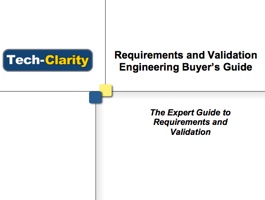 Tech-Clarity’s Requirements and Validation Engineering Buyer’s Guide helps manufacturers develop criteria to evaluate software solutions to support requirements management and validation engineering. Tech-Clarity’s Buyer’s Guides go beyond software functionality to provide a framework of requirements that impact implementation success and long-term ROI, including:
Tech-Clarity’s Requirements and Validation Engineering Buyer’s Guide helps manufacturers develop criteria to evaluate software solutions to support requirements management and validation engineering. Tech-Clarity’s Buyer’s Guides go beyond software functionality to provide a framework of requirements that impact implementation success and long-term ROI, including:
- Software capabilities
- Implementation
- User adoption
- Support
- Vendor characteristics / attributes
- Industry or unique business needs
Please enjoy the summary below, or click the report to download a PDF overview (free of charge, no registration required).
For the full report, please visit our sponsor, PTC, here (free of charge, registration required).
Table of Contents
- Executive Overview
- The Business Value of Requirements Management
- Start with Defining Best Practices
- Define Requirements
- Manage Requirements
- Manage Changes and Approvals
- Enable Traceability, Reporting, and Compliance Management
- Ensure Interoperability
- Support Reuse and Variability
- Verify and Validate Requirements
- Assess Service Requirements
- Consider Vendor Attributes
- Identify Specific Needs for your Company
- Conclusion
- Recommendations
- About the Author
Executive Overview
Fierce global competition means companies have little leeway to bring the wrong product to market. However, today’s products have gotten so complex, it has become increasingly difficult to capture customer and market needs, translate those needs to product requirements, manage them throughout a complex development process involving changes and different configurations, and then make sure the requirements are truly satisfied. A lot of work goes into the initial definition of those requirements, but we do not live in a static world. Changes are inevitable. Tracing all the impacts of those changes, notifying everyone involved, and getting everything updated, including the test case, can be a nightmare. However, with expert requirements and validation engineering practices, combined with the right technology, the process will be far more manageable.
This guide consists of four major sections covering requirements management and validation software tool functionality, service requirements, vendor attributes, and special company considerations (Figure 1). Each section includes a checklist with key requirements to investigate when selecting software tools to support requirements and validation processes.
To set the foundation for expert requirements and validation engineering practices, companies should focus on the entire lifecycle of requirements, not just the definition. This will enable companies to ensure the product they want to bring to market, is the one they actually do. In addition, it will improve the efficiency of the entire process, with fewer errors, leading to higher product profitability.
This guide is not an all-encompassing requirements list. It provides a high level overview for requirements and validation engineering.

